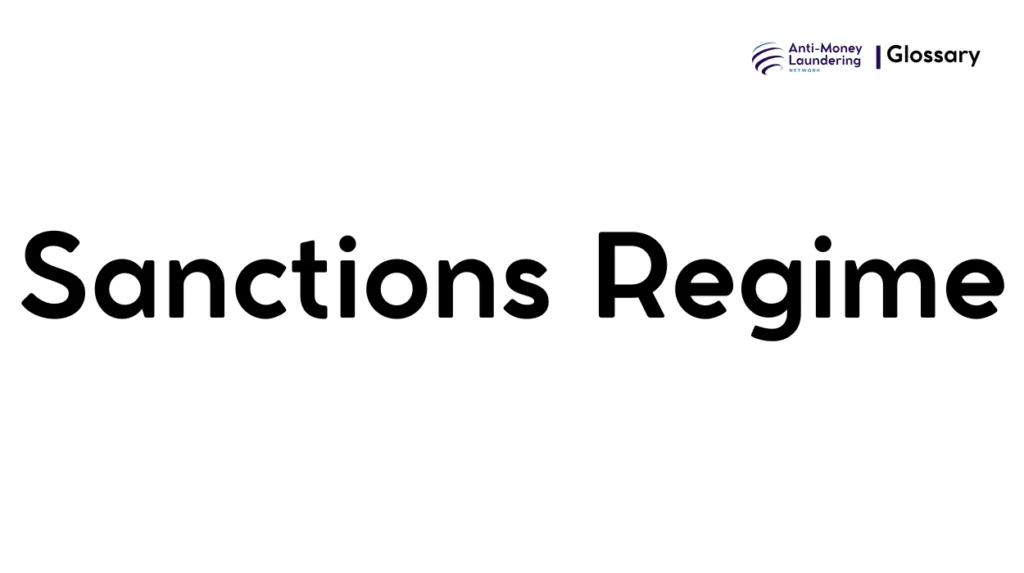Definition
A Sanctions Regime in AML refers to a structured set of legal and regulatory measures imposed by governments or international bodies to restrict dealings with specified individuals, entities, or countries. These measures aim to prevent money laundering, terrorist financing, and illicit financial flows by prohibiting or controlling financial transactions involving designated targets.
Purpose and Regulatory Basis
Sanctions regimes are instrumental in enforcing AML policies by:
- Pressuring regimes or actors to change unlawful or harmful behaviors.
- Preventing the flow of illicit funds tied to terrorism, corruption, or criminal activities.
- Supporting national security, foreign policy, and international peace objectives.
Key regulatory frameworks shaping sanctions regimes include:
- The Financial Action Task Force (FATF) Recommendations, which set international AML standards.
- The USA PATRIOT Act, empowering the US to impose sanctions relevant to AML and counter-terrorism.
- The European Union Anti-Money Laundering Directives (EU AMLD), providing EU-wide sanctions compliance rules.
- The UK Sanctions and Anti-Money Laundering Act 2018 (SAMLA), creating a statutory framework for UK sanctions.
These laws mandate institutions to comply with sanctions by implementing risk assessments, due diligence, and reporting obligations.
When and How it Applies
Sanctions regimes apply whenever a financial institution or entity engages in transactions involving “designated persons” or entities subject to sanctions. Real-world triggers include:
- Transactions with countries under sanction (e.g., Russia, Iran).
- Dealing with individuals/entities listed for involvement in terrorism, corruption, or illicit activities.
- Facilitating payments, financing, or economic resource transfers that involve sanctioned targets.
For example, a bank must freeze assets of individuals on a sanctions list and prevent any transfers benefiting them.
Types or Variants
Sanctions can be classified into several forms:
- Financial Sanctions: Prohibitions on transactions or access to financial markets for designated parties.
- Trade Sanctions: Restrictions on trade with specific countries or sectors, including arms embargoes.
- Travel Bans: Preventing individuals from entering or transiting through certain countries.
- Asset Freeze Sanctions: Blocking access to funds or economic resources of targeted persons or entities.
- Thematic Sanctions: Target issues like corruption, human rights violations, terrorism financing, and nuclear proliferation.
These variants often coexist within a sanctions regime targeting a particular geographic region or thematic concern.
Procedures and Implementation
Financial institutions must adopt robust compliance controls to meet sanctions obligations, including:
- Sanctions Risk Assessment: Evaluating exposure based on geographic jurisdiction, customer profiles, and transaction types.
- Customer Due Diligence (CDD): Screening customers and beneficial owners against updated sanctions lists.
- Transaction Monitoring: Automated and manual review of payments to detect potential sanctions hits.
- Freezing Assets: Immediate blocking of funds or resources related to designated persons.
- Licensing: Seeking regulatory permissions for certain transactions, if applicable.
- Staff Training: Ensuring employees understand sanctions obligations and processes.
- Record Keeping: Documenting all checks, decisions, and reports to regulators.
Institutions often employ electronic screening tools integrated with AML platforms to streamline these processes.
Impact on Customers/Clients
From a customer’s perspective, sanctions regimes mean:
- Possible restrictions on accessing financial services if listed or linked to designated persons.
- Requirement to provide detailed identification information for due diligence.
- Temporary or permanent freezing of assets if implicated.
- Reduced flexibility in conducting certain cross-border transactions.
Customers have rights to be informed of restrictions where possible, but due to confidentiality and security reasons, some information about sanctions actions may be limited.
Duration, Review, and Resolution
Sanctions typically remain in effect until lifted or amended by the imposing authority. Institutions have ongoing obligations to:
- Continuously monitor sanctions lists for updates.
- Review frozen assets or sanctioned relationships periodically.
- Resolve cases through license applications or legal challenges if applicable.
Regulators may also conduct audits or reviews to ensure compliance efficacy.
Reporting and Compliance Duties
Institutions must:
- Report matches or suspicious activities related to sanctions to relevant authorities, such as the Office of Financial Sanctions Implementation (OFSI) in the UK.
- Maintain records demonstrating adherence to sanctions policies.
- Avoid any dealings that could violate sanctions, with breaches potentially leading to severe penalties including fines and imprisonment.
Regulatory guidance emphasizes risk-based approaches tailored to the firm’s size and complexity.
Related AML Terms
Sanctions regimes interact closely with other AML concepts:
- Enhanced Due Diligence (EDD): For high-risk jurisdictions or customers.
- Suspicious Activity Reports (SARs): Filed when transactions suggest sanctions breaches or AML risks.
- Beneficial Ownership: Identifying ultimate owners to avoid indirect dealings with sanctioned persons.
- Customer Screening: A vital control step integrated with AML compliance programs.
Understanding these linkages helps build effective, compliant AML frameworks.
Challenges and Best Practices
Common Challenges:
- Rapidly changing sanctions lists requiring constant updates.
- False positives in screening causing operational burdens.
- Complex ownership structures hiding sanctioned actors.
- Coordinating sanctions and AML requirements simultaneously.
Best Practices:
- Regular risk assessments.
- Automated, updated screening software.
- Staff training and clear escalation procedures.
- Close coordination with legal and regulatory bodies.
These measures help minimize risk and maintain regulatory compliance.
Recent Developments
- Greater use of artificial intelligence and machine learning in sanctions screening.
- Increasing harmonization of sanctions across jurisdictions enhancing cooperation.
- Expansion of thematic sanctions targeting corruption, cybercrime, and environmental violations.
- Updated regulatory guidance emphasizing integrated AML and sanctions compliance programs.
Staying current on these trends is vital for effective sanctions risk management.
Sanctions regimes are a cornerstone of modern AML efforts, designed to prevent illicit financial flows and promote international security. For financial institutions, rigorous compliance backed by risk assessment, due diligence, monitoring, and reporting is essential. Understanding their legal basis, types, and operational impact equips compliance professionals to manage sanctions risks effectively and uphold the integrity of the financial system.

